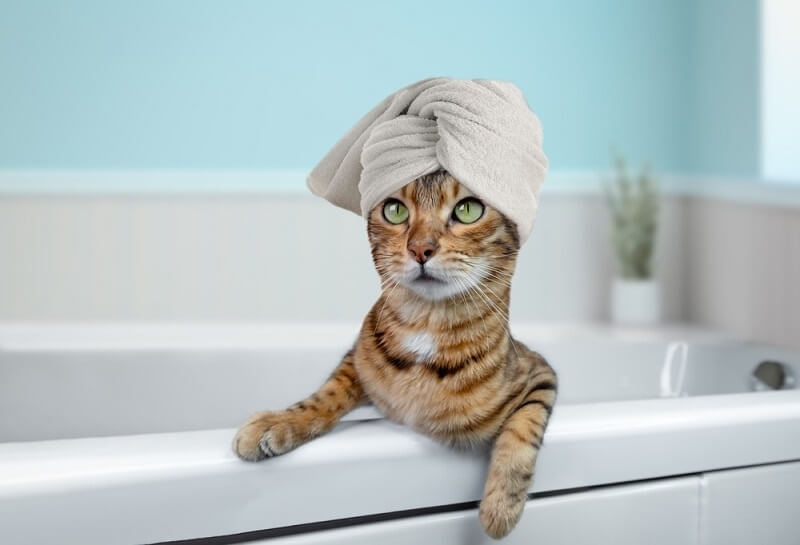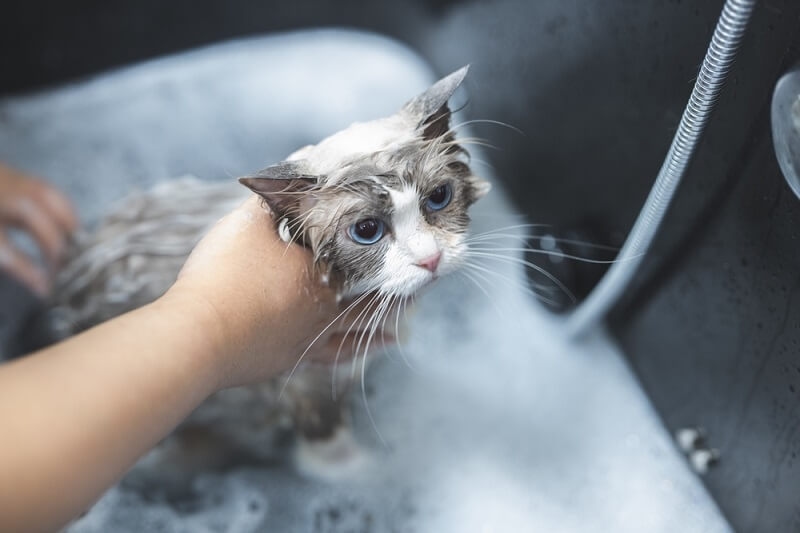
Cat bathing at home may seem complicated, but with preparation, it is easy and enjoyable for you and your cat. Many cat owners have problems because cats dislike water and are easily stressed. Yet, knowing safe cat bathing practices and following a cat shampoo process can create a safe experience for you and your pet. Whether you are searching for tips on bathing cats or long-term feline grooming tips, the procedure can be broken down into stress-free, reproducible steps.
Cats often prefer to take care of themselves using self-grooming. However, there are situations where you will need to help with fleas, allergies, exposure to dirt, illness, etc. Sometimes you will need to bathe the cat at home. Bathing your cat at home will not only result in a clean cat, but you will also be able to examine your cat's skin, fur, and general health.
Preparation is the first step before you can bathe your cat. This preparation process will determine a successful, stress-free bathing of the cat.
Cats tend to scratch when under stress. Pre-trimming their nails reduces the chance of injuries.
Brushing removes loose coats and tangling, making bathing easier.
Use a small but open space like a bathroom. Close the door to prevent escape.
Preparation makes the bathing process much less overwhelming for you and your pet.
All cats require regular baths, but if they do, it is important to follow safe bathing practices. Cats' skin is very sensitive, and if mishandled, it can cause stress, skin inflammation, or even harm.
Cats are susceptible to temperature. The water should be comfortably comfortable—not hot or cold.
Put your cat carefully into the tub or sink. Begin by wetting their paws and working their way up slowly.
Keep the water shallow (2–3 inches). Too deep, and most cats will flip out.
Lather gently, only on areas of concern like paws, hind legs, or oily patches.
Clean the face and ears with a damp cloth instead of pouring water.
These gentle methods ensure the experience is positive for you and your cat.

Bathing cats doesn't necessarily need to be a nightmare. Using tips for bathing cats that reduce stress is imperative:
Cats are highly attuned to human emotions. Use a calming voice during the experience.
The more quickly the bath can be accomplished, the less stressed your cat will become—without hurrying so much that it feels insecure.
After the bath, give your cat their favorite treat. This is a positive reinforcement.
Hair dryers frighten cats. Towel dry them thoroughly and let them air dry in a warm room.
Overbathing removes natural oils. If not medically necessary, give baths only once every few months.
By remembering these washing tips, your cat may not enjoy baths, but they will tolerate them.
One of the most underappreciated aspects of bathing cats at home is the selection of the proper shampoo. Human shampoos are not suitable for cats because their skin's pH levels are pretty different. A proper cat shampooing guide prevents irritation.
All shampoos should always be diluted with water before applying to the fur. This ensures even coverage and reduces the chance of irritation.
Bathing a cat is just one part of keeping your pet clean. Adding regular grooming suggestions for cats to your routine will help ensure your cat has a healthy coat and is happier overall.
Each breed requires different care. Hair cats may need grooming daily, while short-haired cats may
need grooming weekly.
Fleas, ticks, and mites can hide under the hair, so a regular check should be conducted to prevent a full infestation.
Use a vet-approved product to wipe ears gently once monthly.
Oral care is essential. Brushing or using vet-approved chews maintains healthy gums.
Offer scratching posts to maintain nails naturally trimmed and healthy.
By grooming and bathing, you provide your cat with complete care that makes them clean and comfortable.
Mistakes are made even with the best of intentions. To make the process simpler, don't make these mistakes:
Easier and safer by not committing the above mistakes.
Cats are patterned animals and do not deal well with sudden change. A stress-free cat bathing process aims to minimize anxiety before, during, and after the bath.
By prioritizing your cat's comfort, bathing is less of a battle.
Bathing, for cleanliness purposes, is part of a wider grooming routine. Planning bathing cats at home leaves you to do it bit by bit in a predictable routine.
For any special medical requirements, follow your vet's recommendations on bathing frequency.
With this routine, weekly brushing, and ongoing health checks, your cat will be happy and healthy all year round.
Bathing your cats at home is just one aspect of a better grooming regime. To ensure your cat’s coat stays healthy and shiny, your cat's skin stays healthy, and your cat's body stays comfortable, you need to groom your cat routinely. Brush your cat based on their coat type, follow the veterinarian’s chosen ear cleaning regimen, and regularly check your cat for fleas or ticks. You should also watch your cat's nails and dental hygiene, as this is hugely important for long-term care. By understanding and combining the following professional-quality grooming tips for cats, with safe at-home bathing practices, you can accomplish a cat that stays content, healthy, and less stressed.
Bathing cats at home is unlikely to be your pet's favorite activity. Still, if it is completed effectively and approaches the methods discussed, bathing can be safe, efficient, and stress-free! With the safe methods for bathing cats, cat shampooing guidelines, tips for washing cats, grooming tips, etc., you are not just cleaning your pet, but providing health and wellness!
With persistent effort, preparation, and repetition, bathing your cat becomes less daunting and more a responsibility of pet ownership.
This content was created by AI